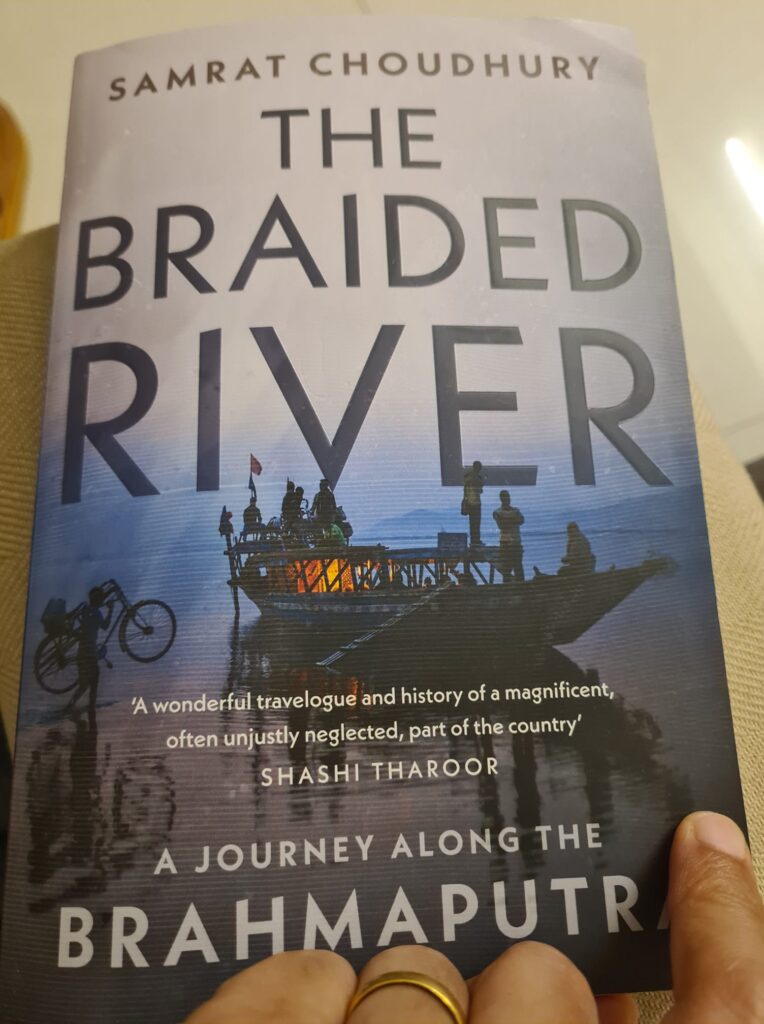“The Braided River: A Journey Along the Brahmaputra”by Samrat Choudhury

Samrat Choudhary’s latest book, The Braided River: A Journey Along the Brahmaputra ( HarperCollins India) is a travelogue in the North East of India tracking the magnificent river. It is so stunning in its beauty. It looks like an inland sea but its a river. There are points that the opposite bank is not visible. Samrat Choudhary and his friend Akshay Mahajan decide to embark on this exciting epic journey of 2000 kms in East India. The North East of India comprises of seven states. The topography of these states vary from the flat plains of Assam to the hill states of Meghalaya, Nagaland, Arunachal, Tripura and Mizoram. Manipur is a mix of plain and hills. Each state has its distinctive culture. It is truly fascinating travelling in this part of India.
The Brahmaputra is very critical to the settlements in this region and has played a pivotal role for centuries. It is revered and feared. It sustains life. It is also part of the local myths and legends.
The North East of India is defined as a region but it has incredible diversity and character. It is meant to be experienced. Samrat X ‘s writing in The Braided River meanders gently recounting the places he visits, topography, meeting people, sharing their histories — the old and the more recent ones of insurgency, the CAA and NRC agitation etc. It is not easy to tell the story of this vast region in an old-fashioned linear fashion. It has to be the way Samrat tells it. He takes you along on the journey while filling in the blanks in one’s knowledge with local gupshup combined with historical details. At times, he quotes from other sources to contextualise a story or a place. It is not an easy task as trying to tell the socio-politcal-history of this region is akin to walking through a minefield. Samrat seems to pull it off.
Much of his narrative does share details in his inimitable chatty style that I can almost hear him reading it out aloud in my head. It is so clear. His descriptions of the place are vivid. Fortunately modern readers have the Internet to immediately look up references. But for me, reading this book brought back a flood of memories. My father/ Romesh Bhattacharji had been posted by the Central government in Shillong ( the capital of Meghalaya) for nearly five and a half years. As a result, we have travelled extensively in the region. So Samrat’s journey on the Ledo Road/Stillwell Road, meeting the Kachins, Digboi, seeing the Lake of No Return in the far distance, visiting Dibrugarh, the tea estates, the opium cultivation, visiting Wild Grass in Kaziranga, Jorhat, and Tezpur are all very familiar. And if we did not accompany dad, then he ensured that he told us so many stories or shared pictures of his travels while touring the seven states that we became acquainted with them so well. Almost as if we had been there ourselves. Hence many of the places Samrat mention come alive for me as well.
For readers unfamiliar with the region, a better map could have been used instead of the tiny one at present. It plots the main cities Samrat refers to but it is not easy to read. Travelogues like “The Braided River” belong to a rich literary tradition of documenting a region. Words are critical. But in modern tellings such as this, perhaps more maps and line sketches could have been considered as tip-ins in most of the chapters. It would have added to the production cost but it would have been a good investment. The two sets of coloured photographs used at present are fine but the production is of such poor quality that they don’t do justice either to the photographer’s composition or to the region. Pity. Perhaps a standalone website dedicated to this book where extracts of each chapter are illustrated by more photographs could be considered. It has the potential of becoming excellent reference material if curated well.
The Braided River is a book that will standout for years to come as a seminal piece of writing about the history of the North East of India where one common factor is the Brahmaputra. There have been so many twists and turns in the socio-poltical landscape in recent decades that an updated, single volume, reportage from the region was sorely needed. Many travelogues, documentaries and films have been made on the river. It is time Samrat Choudhary wrote a new script.
31 May 2021

No Comments